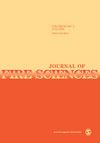Fire-extinguishing performance and gas-phase pollution characteristics of different foam agents in extinguishing transformer oil pool fire
IF 1.9
4区 工程技术
Q2 ENGINEERING, MULTIDISCIPLINARY
引用次数: 3
Abstract
In this study, aqueous film-forming foam, fluoroprotein foam, and synthetic foam were applied to extinguish the transformer oil pool fires. The fire-extinguishing performance and burn-back resistance were investigated using a laboratory fire-extinguishing system. Moreover, the emission products were analyzed to evaluate the gas-phase pollution characteristics. Results show that aqueous film-forming foam presents the highest fire-extinguishing efficiency, while fluoroprotein foam has the best burn-back performance. Flue gas and gas chromatography–mass spectrometer analyses demonstrate that the use of fluoroprotein foam results in much higher CO emissions than other foams, and the pollutants are mainly from various hydrocarbons produced by incomplete combustion of transformer oil. Synthetic foam and aqueous film-forming foam lead to higher SO2 and NO emissions, and pollutants are mainly dominated by alcohols and ethers. Noteworthily, when using aqueous film-forming foam to extinguish oil pool fire, a persistent organic pollutant, perfluorooctanoic acid, is detected in the gas phase.不同泡沫剂在变压器油池火灾中的灭火性能及气相污染特性
本研究采用水性成膜泡沫、氟蛋白泡沫和合成泡沫灭火变压器油池火灾。利用实验室灭火系统对其灭火性能和耐燃性进行了研究。此外,还对排放产物进行了分析,以评估气相污染特性。结果表明,水性成膜泡沫具有最高的灭火效率,而氟蛋白泡沫具有最好的回燃性能。烟气和气相色谱-质谱分析表明,氟蛋白泡沫的使用会导致比其他泡沫高得多的CO排放,污染物主要来自变压器油不完全燃烧产生的各种碳氢化合物。合成泡沫和水性成膜泡沫导致较高的SO2和NO排放,污染物主要是醇类和醚类。值得注意的是,当使用水性成膜泡沫扑灭油池火灾时,在气相中检测到一种持久性有机污染物全氟辛酸。
本文章由计算机程序翻译,如有差异,请以英文原文为准。
求助全文
约1分钟内获得全文
求助全文
来源期刊

Journal of Fire Sciences
工程技术-材料科学:综合
CiteScore
4.00
自引率
0.00%
发文量
14
审稿时长
2.5 months
期刊介绍:
The Journal of Fire Sciences is a leading journal for the reporting of significant fundamental and applied research that brings understanding of fire chemistry and fire physics to fire safety. Its content is aimed toward the prevention and mitigation of the adverse effects of fires involving combustible materials, as well as development of new tools to better address fire safety needs. The Journal of Fire Sciences covers experimental or theoretical studies of fire initiation and growth, flame retardant chemistry, fire physics relative to material behavior, fire containment, fire threat to people and the environment and fire safety engineering. This journal is a member of the Committee on Publication Ethics (COPE).
 求助内容:
求助内容: 应助结果提醒方式:
应助结果提醒方式:


